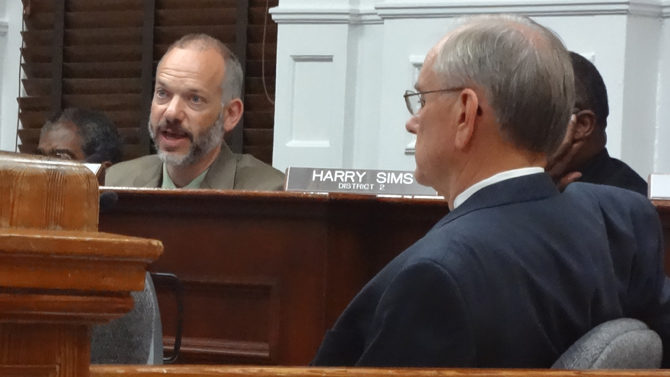“Mr. Berryman,” Commissioner Harry Sims asked the county attorney Tuesday, July 2. “What is this all about?”
A good question. Ostensibly, it was about whether Selig Enterprises could build 15 ground floor apartments along Wilkerson Street, rather than the commercial space the Athens-Clarke County code requires. Legally, that was true. As with many of these zoning throwdowns, though, it was about much more than that.
How Did We Get Here?: Opponents chafed when Selig’s lawyer, Mike Morris, told the commission that, “While it’s important to us, (the special use permit) is not a deal-breaker. This project is going to get built.”
Morris may have come off as a bully, but he was right. The narrow issue of the 15 apartments was the only one on the table.

Photo Credit: Blake Aued
Russell Edwards and Sanni Baumgartner look sad as it becomes clear the Selig development will pass. Or maybe Russell just has something stuck in his teeth.
It didn’t have to be that way. ACC’s 2000 comprehensive plan allows 200 bedrooms per acre—twice the 990 bedrooms on more than nine acres Selig is building. Other than a 100-foot height limit, there’s no limit on commercial space (110,000 square feet, in Selig’s case), nor is there a limit on parking (1,475 spaces).
Though architecturally uninspired, the development also meets ACC’s downtown design guidelines, brought to us by out-of-town consultant Nore Winter and approved in 2006.
The same year, the commission finally created a downtown historic district. But lo and behold, it only included a core six-block area—not the historic warehouses off Oconee and East Broad streets.
When Selig first proposed the development in 2011, commissioners declined to contest Berryman’s interpretation that Selig had “vested rights” in the Armstrong & Dobbs property—meaning that ACC couldn’t change the rules in the middle of the game—even though other experts, like the University of Georgia’s Jamie Baker Roskie, disagreed.
Commissioners also didn’t pursue the publicly-funded river district—intended to head off more student apartments by building a research park and recreational amenities—fast enough to secure the A&D property ahead of Selig. Possibly, the Atlanta developer had the help of Mayor Nancy Denson, who kept news of its interest under her hat for months before telling the Economic Development Foundation (in an illegally closed meeting, no less).
Nor would the commission change the zoning in the eastern part of downtown to allow 55 bedrooms per acre in 2012, even though planners said the area didn’t have enough water and sewer capacity for maximum build-out.
At any of those points, we could have put a stop to this development and others like it.
The Compromise: So, about that Transportation Corridor Concept Map. It’s a map (duh) where ACC officials mark off places where they might one day want to build roads or trails, so they’re protected. As first reported in Flagpole two weeks ago, an old rail bed called the Belt Line runs through the A&D property and was intended to serve as a level connection between Firefly Trail and the UGA campus, bypassing a steep hill.
Commissioner Jerry NeSmith raised a host of policy and procedural questions at the meeting about the rail-trail and the TCC map, all explained away by Planning Director Brad Griffin under questioning by Commissioner Andy Herod. Planners said the specific corridor wasn’t protected; only the concept of a level connection was required.
Commissioner Kelly Girtz worked with Selig to remove a retaining wall along Firefly Trail, add a shallower ramp from the rail-trail up into the development and add 10-foot-wide bike paths and sidewalks, separated from car traffic, along the Hickory Street extension that will run through the development.
Girtz’s proposal passed by an 8-2 vote July 2, with Jared Bailey and George Maxwell voting “no.” It was as good a deal as we were going to get. It accomplishes the same things as a trail along the Belt Line would have—a safe path through the development for cyclists and pedestrians, and a level connection from Firefly Trail to campus. Selig also will have to come back for approval of the connection’s design. NeSmith even voted for it after Girtz added a clause to his motion requiring Selig representatives to meet with the Rails-to-Trails Committee and the Greenway Commission.
Girtz only released his plan the day before the vote, though, and speakers at the meeting asked for more time to digest it. As Russell Edwards, echoing many local citizens, put it: “Why not wait a little bit? What’s the harm?”
Girtz said he saw his motion as just a minor tweak to Selig’s plan, but Selig skeptics were right. There wasn’t enough time for the public to weight the ramifications. Delaying the vote for a month would have inspired a lot more confidence in the commission’s actions.
What’s Next: Even though many felt like they “lost,” everyone who opposed or critiqued the Selig development really won. They simply didn’t have the tools to stop it, but the company substantially improved the plans because of community feedback.
“The Selig project I looked at 18 months ago bears no resemblance to the current project,” Commissioner Kathy Hoard said. “I think that has a lot to do with the people in this room.”
Clearly, though, the zoning laws and design guidelines approved, with input from citizens, by our duly elected representatives in their infinite wisdom, have some unintended consequences and need re-evaluating. They’re not giving us the kind of growth downtown that most of the community seems to want.
So that will be the next big fight. Now, if only we could get as worked up about actual human beings—the poor, the struggling students, people without health care—as we do about a pile of bricks.
Like what you just read? Support Flagpole by making a donation today. Every dollar you give helps fund our ongoing mission to provide Athens with quality, independent journalism.










